Over the recent decades, collecting and storing large amounts of data has opened the door for businesses to analyze it, discover patterns and apply actionable insights. In the last few years, AI and advanced data analytics have moved big data – the collection of vast, complex datasets – to the forefront of operations and strategy.
The trends that emerged in the last decade have also been driven by the unrestricted growth of social networks, global online services, and affordable IoT componentsI. Now we have dozens of big data trends that help businesses maintain an up-to-date strategy to compete in the market, including infonomics, DataOps, Gen AI in data management, and predictive analytics.
However, the implementation of big data strategy is complex: companies still need to overcome a few challenges to benefit from data-driven advantages. It requires extensive expertise and knowledge of the constantly developing technologies.
The engineers at Intellias thoroughly evaluate each trend and only implement the ones that are future-proof for business. For example, when working with a national telecom provider, Intellias created a cloud-based data architecture from scratch, helping the client get an 85% CPU load reduction and cut its processing time by two-thirds. These achievements allowed our client boost their productivity, performance, and business growth.
12 Big data analytics trends to watch for 2024
Companies able to harness the potential of data, distinguish the most promising solutions among all the big data industry trends, and adopt the hottest technologies in this domain will enjoy countless advantages and take the lead in the competitive market.
1. Infonomics
According to Doug Laney, former VP of Gartner, infonomics, one of the latest trends in big data, is “the theory, study and discipline of asserting economic significance to information. It strives to apply both economic and asset management principles and practices to the valuation, handling and deployment of information assets.”
In simpler terms, infonomics treats data as a commodity-like substance. After all, if data can substantially improve forecasting results and therefore boost sales or minimize losses; if it can help target the right consumer cohorts with the right products; and if it can improve public safety — why shouldn’t it be treated as a valuable resource, just like rare metals or fossil fuels?
Infonomics model: measure, manage, and monetize information
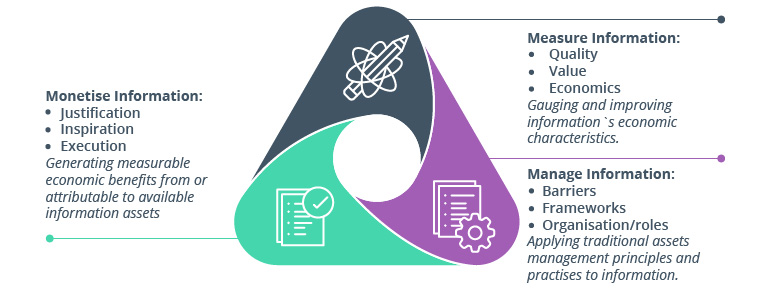
Source: Gartner
In the future, data will be gaining more and more market traction as an object of trade and exchange, and the fuel powering the rapidly growing industries of data science and ML engineering. Even today, big data is something that many global businesses simply won’t survive without, which means that business leaders should be treating their big data strategies with all seriousness.
Some examples of data being sold as a product can be drawn from world-renowned sources of business intelligence, such as NielsenIQ, Acxiom, and, more recently, Dawex, an innovative global data exchange marketplace.
2. DataOps
In a world getting increasingly dependent on data and data-driven decisions, trends in big data analytics and the overall success of big data initiatives will be governed by DataOps, an emerging operational framework and a set of best practices in the big data space.
The DataOps cyclic process
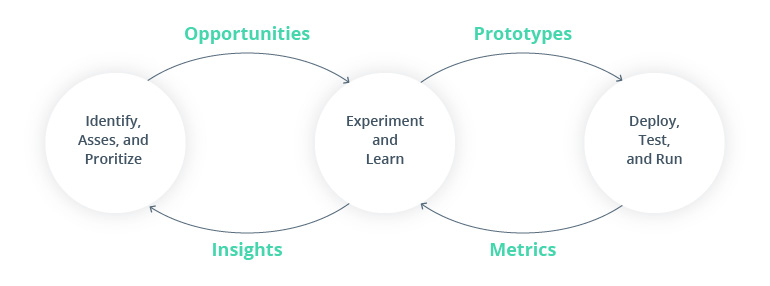
Source: Ryan Gross, Medium
Those who say that DataOps is essentially DevOps for data are right in that DataOps can do as much good for data science as DevOps has done for development. However, it’s a much wider notion, despite the apparent semantic similarity. IBM, for instance, defines DataOps, as “the orchestration of people, process, and technology to deliver trusted, high-quality data to data citizens fast”.
Similarly to DevOps, which does not consist of continuous integration and continuous delivery only, DataOps as one of the key big data analytics trends is more of a philosophy than a set of delivery approaches. This fusion of architectural approaches, cultural elements, agile practices, lean production techniques, statistical process control (SPC), and good old DevOps strives to achieve the following:
- Exceptional quality of results coupled with a very low error rate
- Effective collaboration across teams, business units, companies, technology stacks, and heterogeneous environments
- Rapid adaptation to changing requirements and conditions
- Non-stop, high-speed delivery of meaningful, high-value insights to users
- Ease of measuring and monitoring data flows
- Full transparency of results
3. Internet of Things
Global spending on IoT was estimated at $805.7 billion in 2023 and is expected to grow even more over the years. This technology, combined with AI and 5G, changes the way things work in the world. It promotes interconnectivity, ensuring various devices work smoothly within a single large network.
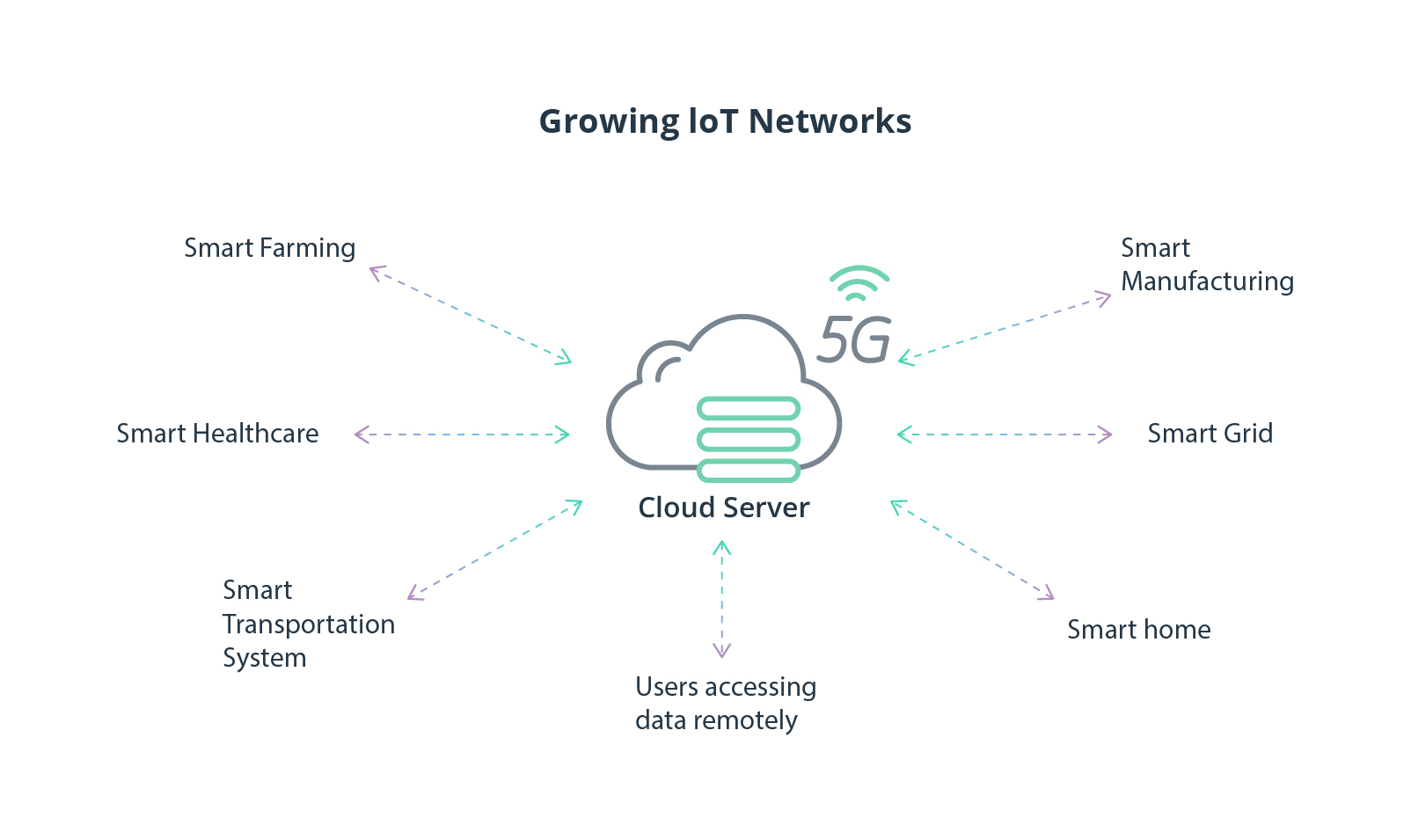
Some real-life applications of IoT include:
- Smart homes: thermostats, lights, security systems, household appliances, and other devices that are connected and controllable from a single interface;
- Healthcare and wearable devices: smartwatches, patient monitors, smart pills, and similar technologies that provide healthcare providers with instant feedback;
- Smart agriculture: soil sensors, drones, livestock monitoring devices, and others that are popular in the farming industry. We covered how to implement big data analytics in agriculture in our previous articles with expert opinions.
This is one of the big data trends that is already becoming part of our daily lives, so you can expect to see it everywhere, from manufacturing to marketing.
4. Generative AI in data management
One of the latest trends in big data management is the usage of generative AI. Artificial intelligence is capable of automating data processing by 90%, significantly reducing manual workload and allowing engineers to focus on more important matters.
As one of the top-tier big data analytics trends, it is used in the following ways:
- Augmentation and synthesis: creating synthetic data that mimics real-world data in limited datasets. This is great for large-scale research projects;
- Cleaning and preparation: AI identifies and corrects inconsistencies or errors in datasets, helping you maintain integrity. It also automated transformation into the required formats;
- Integration and migration: AI can automatically map data schemas from different sources and harmonize data from disparate sources for a unified dataset;
- Analysis and insights: you’ll get predictive models that forecast trends and generate potential scenarios with outcomes. It’s great for retail, banking, and many other industries to get future insights that can have a great financial impact.
It’s also necessary to note the NLP capabilities in one of these big data trends. The rise of various GPT models ensures AI can generate comprehensive reports and summaries from raw data. It easily interprets queries and supports professionals in their work, so it’s definitely a step into the future.
5. Predictive analytics
Predictive analytics is one of those trends in big data analytics that are frequently discussed and used by Google, IBM, and other tech giants. Type a search query and you’ll get a search recommendation, buy a product online and you’ll get suggestions on “what comes best with it”. It’s already everywhere.

Source: Aberdeen
Some of the leading applications of predictive big data trends are:
- Forecasting: you’ll get various simulated scenarios combined with gen AI and nearly instant time series data analysis for trends, patterns, and possible anomalies;
- Personalization: big data industry trends emphasize the importance of predicting customer behaviors and providing them with dynamic recommendations for better conversions;
- Security: AI analyzes transaction patterns to identify fraudulent activities, anomalies, and unusual behaviors. This phenomenon is particularly prevalent within the fintech industry. You can check out the fintech industry trends in our previous article.
Predictive big data trends support companies with deeper insights and better predictions. This helps them monetize all opportunities by making data-driven decisions.
6. Interconnectivity
One of the greatest challenges that adopters of big data technologies will face is how to deal with disparate and siloed data sources. And their attempts to solve this problem leads to the appearance of new big data industry trends.
Every large organization operates multiple systems scattered across departments, production facilities, branches, and geographies. Each system may potentially have a unique data storage format and a set of security requirements, thus creating a need for complex ETL manipulations.
The success of any digital transformation will depend heavily on the ability to centralize data processing and storage, create company-wide data pipelines, and implement universally accessible data analysis tools.
The key hurdles for resolving interconnectivity issues will include the following:
- Developing an effective data engineering strategy
- Synchronizing data streams across all data sources
- Making data pipelines flexible and scalable to withstand future growth
- Implementing reliable data security measures
- Embedding accuracy and quality control mechanisms across the board
- Devising an effective and efficient cloud data storage model
These operational challenges can only be solved by means of tight cooperation between a company’s business and technology stakeholders, as well as an in-house or hired team of professional data engineers and data analysts.
7. Chief Data Officers
Chief Data Officers (CDOs) are among the latest trends in big data analytics. They help organizations use data as a valuable resource. In 2022, around 27% of companies hired a CDO to support their strategies in big data engineering.
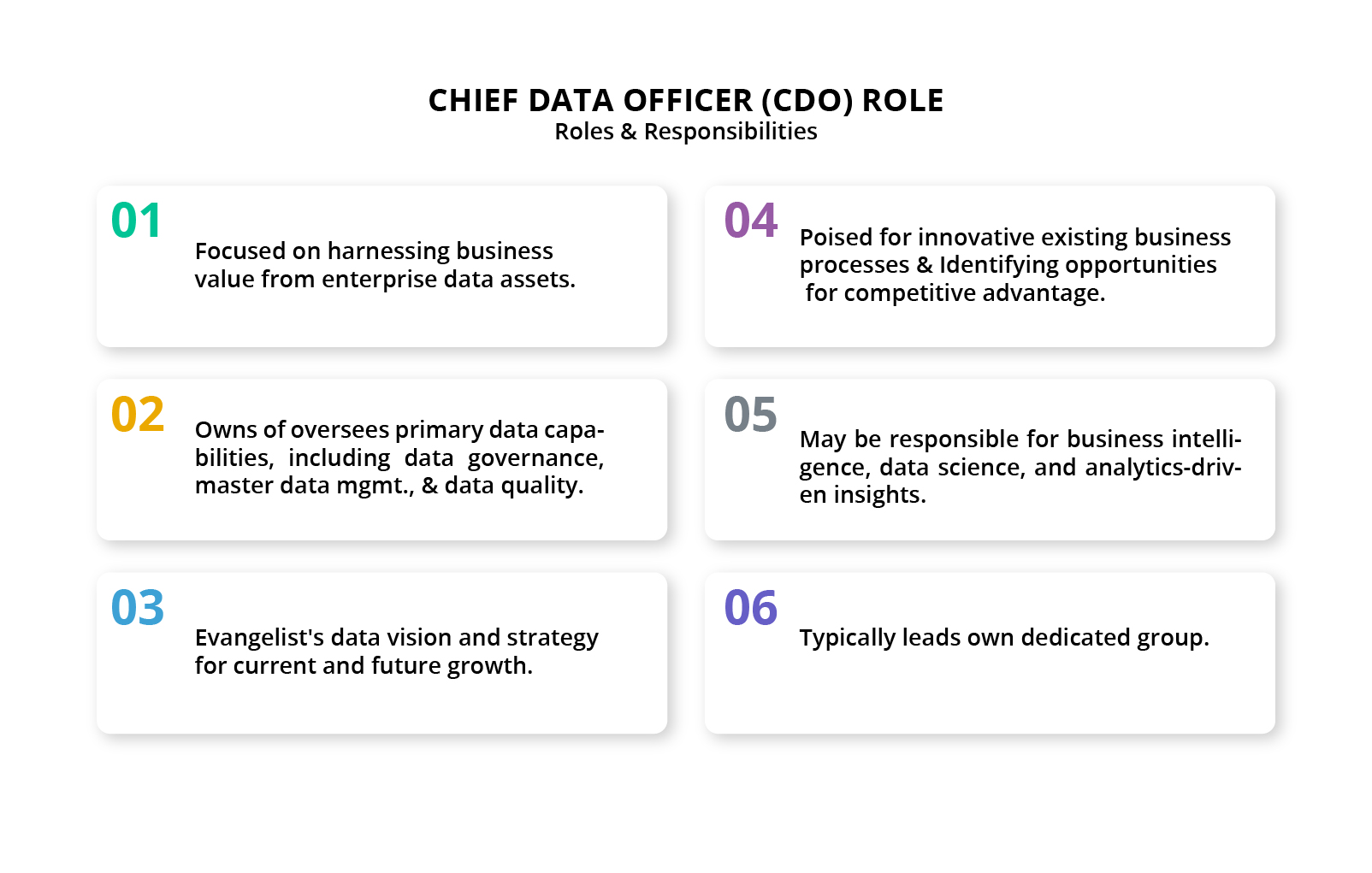
Source: Dataversity
A chief data officer supports your company with:
- Improving data quality and governance: they know the right tools to automate data cleaning and ensure compliance with all data protection regulations;
- Better data strategies: big data trends require CDOs to analyze emerging trends to find opportunities for growth and drive innovations to get a competitive advantage in the market;
- Advanced data security: a CDO knows how to protect your company’s systems from unauthorized access and anonymize sensitive data to comply with regulations.
CDOs generally help companies with immense tech expertise and proficiency with modern technologies, allowing them to maximize their data’s value. Hiring a chief data officer is a must for data-driven organizations.
8. Data fabric
A data fabric is an architectural approach created to optimize data management and access across disparate systems and environments. This includes on-premises, cloud, and hybrid setups. It provides a centralized data management framework that integrates various data sources.

Source: Spiceworks
Data fabrics are among the big data technology trends due to their benefits:
- Better data availability;
- Increased data quality;
- Improved time-to-insight;
- Reduced data management costs;
- Simplified data management process.
They are commonly used in the telecom sector. You can learn more about big data solutions for telecom in our previous blog posts written by the engineers at Intellias.
9. Data mesh
A data mesh is a decentralized data architecture approach that treats data as a product, decentralizing the ownership and management of data to domain-specific teams. This contrasts with traditional centralized data management approaches.

Source: Kellton
A data mesh is one of the future trends in big data analytics due to its:
- Scalability;
- Cost-efficiency;
- Data quality;
- Enhanced security and compliance;
- Improved data discovery.
Using a data mesh architecture is essential for telecom operators due to its principles. They allow operators to make informed decisions with accurate responses from analytics systems. Read more about big data in the telecom sector in our previous articles.
10. Data governance
Data governance is the process of making sure data is available, usable, and secure in an organization. It includes policies, processes, and standards that make sure data is used properly.

Here are some issues covered by this trend:
- Regulatory compliance;
- Risk management;
- Data consistency;
- Data quality, and more.
According to Harvard Business Review, only 3% of data in companies meets basic quality standards. One of the steps to fix this issue and improve the quality is data governance. Its market size reached $3.27 billion in 2024, so data governance has proven to be a popular and effective approach.
11. Quantum computing
The notion of big data future trends is inseparable from quantum computing. As the amount of data generated by computer systems keeps growing exponentially, it will inevitably come into conflict with the limitations of today’s hardware approaching its physical limits, as per Moore’s law. Dramatic performance improvements will require a “quantum leap” in the raw processing power of future CPUs, and quantum computing will be the answer and another mighty solution out of all spectrum of latest trends in big data.
Quantum computing may still be in the making, but its future potential is not to be underestimated. Major players like IBM and Google, as well as a number of high-tech startups, have spotted its potential amongst other trends in big data analytics and are already making steady progress in this area. Once mature enough and commercialized, the technology will be put to good use by large enterprises and science labs around the world to tap into the vast array of data that remains untouched and unprocessed today.
As hardware manufacturers push the envelope to harness those cubits, software companies like Microsoft are laying a foundation for the future of big data science by developing corresponding frameworks and online platforms — check out Azure Quantum, for example.
12. Data security
In the world of big data, cybersecurity is an equally big deal, outlining another tendency within big data future trends. Data analysis systems can be deployed in or collect data from such areas as finance, healthcare, insurance, and many others — all rife with confidential personal and business information. Compromising this data may have severe ramifications and pose major risks to affected individuals and companies.
At the same time, security measures cannot be implemented exclusively at the storage level. Big data systems have complex architectures and consist of multiple distributed components and data sources, which makes the enforcement of security policies a challenging, never-ending process.
Given the current technologies and big data analytics trends, the following potential security-related issues should be taken into account:
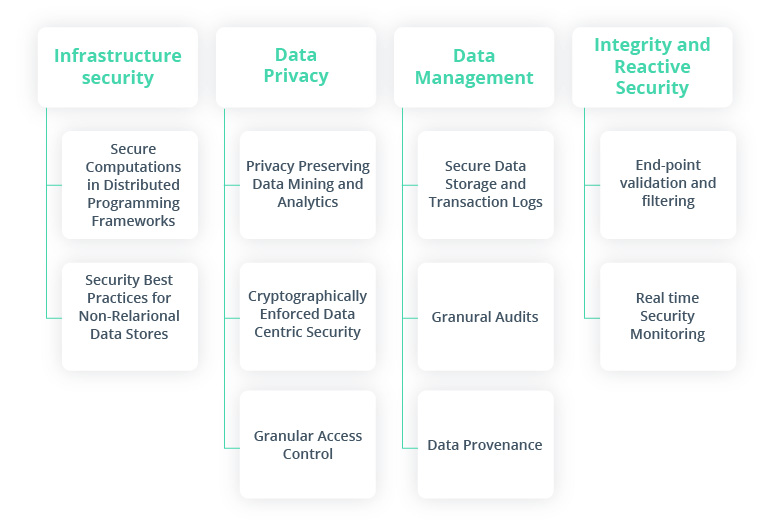
Source: Shaveta Jain, Researchgate
Companies that are just starting to follow trends in big data analytics and think of the adoption of big data technologies may be concerned about having little control over sensitive data that’s stored and processed in public clouds using third-party tools. In this case, a multi-cloud strategy can help maintain a healthy balance between security and operational efficiency.
Big data market forecasts
According to Fortune Business Insights, the big data analytics market was valued at $307.51 billion in 2023 and is projected to reach $924.39 billion by 2032. This means the industry is booming and it’s going to be a giant trend in the next decade. The revenue forecast is even bigger, anticipating $103 billion in 2027.
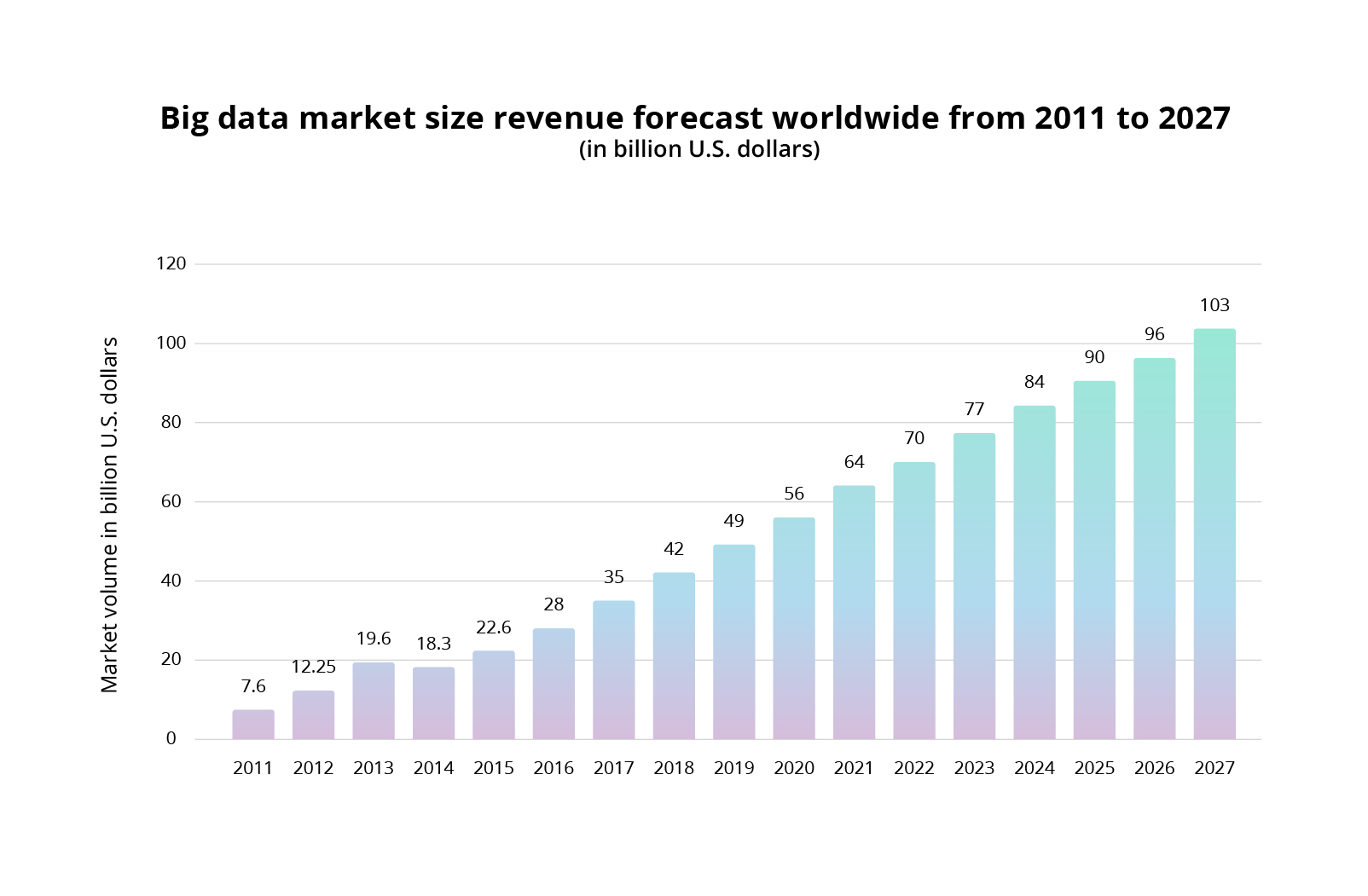
Source: Statista
Let’s check out some other statistics in the big data industry:
- The travel, transport & logistics, and retail industries are expected to benefit the most from AI analytics in big data – McKinsey;
- Around 2.5 quintillion bytes of data are created each day, with over 44 zettabytes of data in the entire world – Forbes;
- The number of global IoT devices is around 17.08 billion in 2024 and is expected to reach 29.42 billion by 2030 – Demandsage;
- 50% of US executives and 39% of European executives mentioned their budget constraints are the top issue when trying to profit on big data – Capgemini;
- 43% of IT managers think their systems won’t handle future data requirements – Dell Technologies;
- Netflix saves $1 billion yearly with its recommendation algorithms, which influence 80% of all the content watched – Inside Big Data;
- 68% of travel agencies plan to allocate resources to predictive analytics and business intelligence – Statista.
As you can see, big data is a core element in many activities. It’s one of the greatest factors in increasing your company’s income with data-driven decisions and solutions.
Future outlook and predictions
Our big data engineers have an extensive background in the industry from past years, so they have a clear vision of its future growth. Considering the current trends and use cases, here’s what we can expect over the following years:
- Businesses will use data manipulation to analyze, predict, and quickly respond to changing market demands;
- Big data analytics will play a crucial role in helping R&D teams develop innovative products and services and in active product development;
- Clean, prepared, and shared data will become a commodity in a growing number of places;
- Organizations will create more varied data lakes to make it easier to reuse data;
- Businesses will use Generative AI to develop highly personalized content and improve decision-making processes, driving more targeted and effective business strategies;
- Generative AI will help companies analyze large datasets, uncovering hidden patterns and generating valuable insights that would be difficult to detect manually;
- More low-code and no-code solutions will enable non-data analysts to use prepared data sets for software development and analytics.
These are only some of the insights in the big data industry. Many other trends will emerge with the rapid development of AI and ML, bringing us a few steps closer to the future with each day.
The Intellias experience
Intellias has been in the market for more than 20 years. The company collaborates with AWS, Google, and Microsoft to deliver cutting-edge solutions using their products. You’ll get end-to-end services that ensure your project is supported by a long-term partner who knows the industry inside out.
Here are our leading data engineering case studies:
Advanced Big Data Analytics Platform for a National Telecom Provider.
- A leading telecommunications company needed a cloud-based data structure designed and tested. This helped the company reduce CPU load by 85%, accelerate data processing time by 3 times, and optimize the total cost of ownership.
AWS Migration Services for Seamless Big Data Analytics in Telecom.
- We developed measures to assess the AWS migration strategy’s infrastructure cost optimization and thorough data analysis. This helped the company enhance data processing efficiency, optimize resource costs, and improve customer retention.
Location Big Data Analytics for Enhancing Business Intelligence.
- We started a research project to make a tool that analyzes location data to help businesses work better by using data. This enabled companies to predict fleet behavior, forecast traffic conditions, and make informed business decisions.
Conclusion
Global services such as Google Search and Facebook rely on hundreds of internal services and components based on big data, AL/ML, and deep learning — and most users don’t know that data is the driving force behind the magic they love. Big data has made its way into business, and it continues to make strides, from personalized recommendations on smartphones to infrastructure management of smart cities.
Partnering with Intellias empowers your company to unlock the full potential of your data. Our team has the experience to create and implement robust big-data solutions that incorporate the latest trends. We guide you through defining your business objectives, selecting the optimal tech stack, and ensuring seamless implementation with 24/7 support. Contact us today to modernize your data strategy and strengthen your business with our advanced solutions and expertise.


